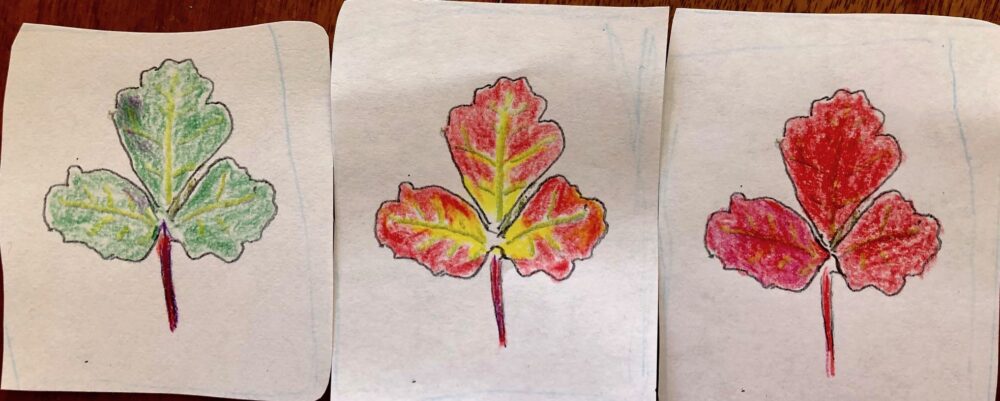By Sue Watts
I took my smoky tea and my old, cold bones down to a sunny patch by a stream in the Pecos National Forest. Across the stream, a trio of skinny aspens had changed from yesterday’s light green to a pale, yellow-green. The green chlorophyll was draining away leaving the yellow and orange pigments (carotenoids) that had been hiding all summer to have their moment of glory. At home, I learned that carotenoids also help protect the leaf by releasing excess energy as heat, thus slowing the process of transition to keep the plant from degrading.
I began to wonder how fast it would take for an aspen leaf to turn from green to a pure buttery yellow. Would scrub oak leaves or three-leaf sumac (shown below) or those of other species have a different time frame to turn from green to orange to a ruddy brown? Would different trees of a single species change at the same pace? How could I figure it out? Could I answer that that through observation?
What if I made a leaf timeline where I could record the changes? Back home, I could pick out a green leaf on a tree in my yard. While leaving it on the tree, I could check it every day for changes and record them. I could draw several outlines of the leaf and use colored pencils to record the changes as they happened. If I wanted to go deeper and further into the observations, I could pick out different trees and keep track of them.

For further leaf investigations, I could pick a colorful leaf and spend a FULL minute itemizing everything I could notice about the real leaf. Psst, it helps to speak out loud and to keep going for the full minute … some of the most interesting observations come towards the end when you’re searching for more details. Taking the adventure further, you could spend a full minute completing the sentence “I wonder…”. Again, the most interesting “wonders” come at the end. Figure out how you would go about answering that.
For a really neat lesson on how to draw leaves, you can check out John Muir Law’s lesson on leaves. It takes about an hour, but you’ll come away with a process to help you focus on progressively detailed observation.
As an aside, while observing things in nature, random thoughts come to mind. I’m at the three-quarters of a century mark age-wise and one of my “I wonders” went this way … I wonder how many years I’ll be able to revel in the shimmering dance of the aspen leaves before I meet the “end of the road sign.” Whoa! The answer came loud and clear as a wind blew several leaves from the tree: revel in it NOW and let the future roll out as it will. I got the message … know when to let go. It’s as easy as drifting to the ground.
What do the changing and falling autumn leaves tell you?
If you enjoyed this blog, consider joining our new email group, called “Let’s Journal.” Members can share observations and Sue and Terry will provide brief hints about writing or drawing what you observe. Request to be subscribed to the email list by emailing publicity@peecnature.org.

Sue, you’ve so exemplified what happens when you notice something in nature—you begin to wonder, your questions lead you to more focused attention and how you might discover some answers. And perhaps some wisdom about how to live your life. Two days ago in late afternoon when the sun was getting low in the sky I was in the kitchen and happened to catch the remaining leaves on the aspen in the front yard glowing with light when everything else was muted. Yesterday it had lost all but a few leaves and today the tree is completely bare. How lucky I was to see it in its glory!